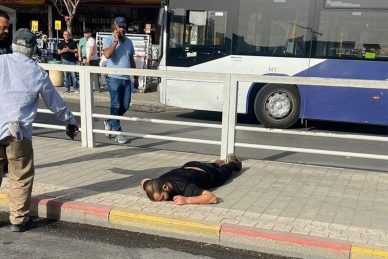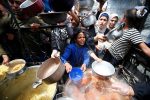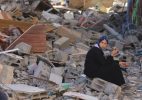In the far south of the Palestinian desert in the Negev where the warmth of the place is felt a tall minaret and a white dome and beautiful corridors could be seen but they speak of injustice committed against the Palestinians by the Israeli oppressors. A beautiful Islamic architectural masterpiece with its Andalusian windows and doors decorated with marble columns extracted from the stones of Palestine the Great Mosque of Beersheba is standing there.
The beauty of the place could be felt due to its green spaces where olive palm and cedar trees are planted yet misery is there instead due to the absence of Muslim worshipers due to the measures of the Israeli occupation since the Nakba (catastrophe) of 1948.
Historical roots
The Ottomans built the Great Mosque in 1906 at a time the Ottoman Empire was nearing its eclipse. It was the first mosque to be built in the city of Beersheba the capital of the south of Palestine which was a meeting point between the tribes of Hebron Gaza and the Sinai. For people moving there the Mosque served as a rest station and a food providing point. The Mosque embraced between its corridors people coming from the Levant to Egypt as well as those coming from Egypt to Palestine and the Levant where they could rest eat and sleep in its wide yards. This was confirmed by the Palestinian historian Arif al-Arif who served as the chairman of Beersheba council in the 1930s in his famous book “The History of the Beersheba and the Negev Tribes.”
The Haganah massacre
In 1948 and during the Nakba the Zionist gangs known as the Haganah invaded the city of Beersheba under the protection of the British forces and turned its mosque into a detention center where hundreds of Palestinian and Egyptian prisoners were massacred. The Zionist gangs killed dozens of them after one of the Zionist soldiers threw a hand grenade inside the mosque and among the prisoners scattering their flesh and blood all over the walls of the mosque and its yards.
The prayer in the Mosque of Beersheba has been banned since the occupation of the city in 1948.
In 1952 the mosque was transformed into a museum called the Negev Museum. The decision was made by the Israeli architect of the town of Beersheba Zeppi Ofer who allowed visitors and tourists to enter the museum in return for fee and to climb its minaret.
After several renovations of the mosque and development of the museum it was given a new name: The Museum of Islamic and Orient Civilizations. The Israeli authorities put inside the mosque-turned-museum a lot of Byzantine stones artifacts and mosaics dating back to the fifth and sixth centuries as well as a solar clock made of white stones with Byzantine letters placed inside it. The museum attributed these antiques to the fabricated Israeli-Zionist history.
Revolution of anger
The Palestinians struggled and fought several public and legal battles with the occupation authorities to restore their religious sites one of which was the Great Mosque of Beersheba. They held prayers in the yards of the mosque and organized sit-ins and demonstrations in front of the Knesset and the headquarters of the government. The Islamic Foundation for the Defense of Waqf filed several legal cases against the Judaization of the mosque. In June 2011 an Israeli court ruled out that the mosque is a special museum for Islamic culture and Eastern peoples. The mosque was used for weekly performances and concerts.
In August 2002 the Palestinian public revolted against a decision by the Beersheba Municipality to hold a wine festival in the yards of the Beersheba Great Mosque in which more than 30 wine factories were to participate.
Tens of thousands of Palestinians gathered in the yards of the Mosque and its surroundings despite the military checkpoints and fortifications. The protesters believed that the festival is an aggression against the feelings of Muslims. The crowds and protests continued for several weeks including performing prayers. This also included filing several lawsuits with an Israeli court in Jerusalem that finally ruled out in favor of canceling the wine festival because it is “a disgrace to the Islamic religion” according to the court.
Protection of holy places
Sheikh Ikrema Sabri the head of the Islamic Supreme Commission said that the Islamic movement’s sit-ins and protests in the occupied territories of 1948 protected holy sites from violations and Judaization.
He said in an exclusive interview with the PIC “The Islamic Movement and through the Foundation for the Defense of Religious Endowments and Islamic Sanctities has been able to recover many mosques and cemeteries restoring and protecting them from Judaization such as the Hassan Bek mosque on the outskirts of Tel Aviv and al-Ajami mosque and the Sea mosque in Jaffa and the mosque of Tiberias and Bisan. Yet the Israelis are determined to continue the Judaization of the mosque of Beersheba although it is an Islamic mosque and it has been registered for more than one hundred and ten years in the records of Islamic Waqf.
Sheikh Jumaa Al-Qassasi a leader in the Islamic Movement in the Negev told the PIC: “We will protect our mosques and religious sites by our bare chests. The Islamic Movement has carried out hundreds of public legal and political activities to protect Islamic sanctities from Judaization. Many of our leaders have been arrested but this will not deter us from continuing defending our sanctities and religious sites.”
He added “We in the Negev are working hard to protect our mosques and the Great Mosque of Beersheba. We are working hard to recover and use it for prayer again. In spite of the occupation and the issuance of many court decisions to classify it as a museum we will not surrender.”
Ibrahim Sarsour a former deputy of the Islamic Movement in the Knesset told the PIC that the Israeli authorities’ decision to close mosques and Judaize them is racist and in violation of international laws and norms.














